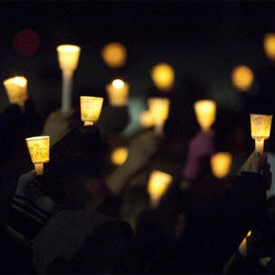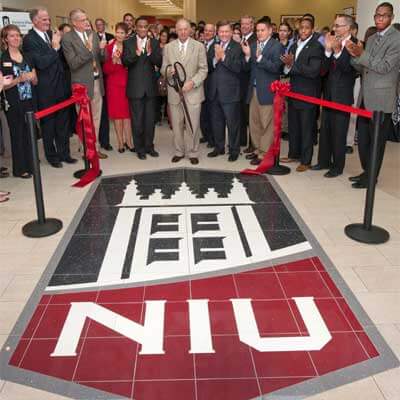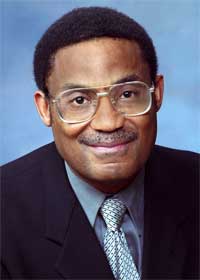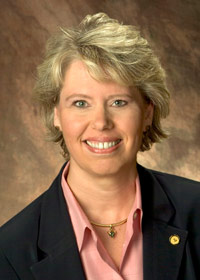The Northern Illinois University Board of Trustees, in issuing a proclamation at the start of its June 20 business meeting, conferred John G. Peters with status as president emeritus, effective July 1.
Known as the students’ president, Peters has led the university over the past 13 years.
“NIU and its Board of Trustees have benefitted tremendously from John’s steady leadership and deep understanding of higher education,” says board chair Cherilyn G. Murer. “Not only does John have a profound knowledge of national higher education issues, he also put together a tremendous leadership team who, along with his guiding hand, successfully managed the vast array of departments, budgetary and policy resources and obligations of NIU.”
The proclamation cites Peters’ “distinguished and exemplary service as president… as the senior and highly respected dean among the presidents of Illinois public universities.” It also notes his accomplishments in numerous areas, including private fundraising; securing federal funding in support of the academic programs, research and student and public services of the university; building campus infrastructure and beautification; compassion, dignity, strength and leadership during the immediate and continuing aftermath of the February 14, 2008 tragedy on campus; and regional and national leadership in collegiate athletics.
It would be an impressive list of accomplishments for any university president, although early in his career Peters never had his sights set on becoming the head of a major university. “It just happened that I became an accidental administrator,” he says.
A native of Strongsville, Ohio, Peters earned his Ph.D. in political science from the University of Illinois at Urbana-Champaign in 1975 and accepted a position teaching political science at the University of Nebraska. While he relished his time teaching and researching, he agreed in 1983 to serve as associate to the dean of the College of Arts and Sciences. By 1988, he was the college dean. Five years later, he became the University of Tennessee’s provost, or chief academic officer.
When search firms began approaching him about presidential openings, Peters showed little interest. But as their son, Russell, prepared to depart for college himself, Peters and his wife, Barbara, began to wonder if they had something to offer.
John Peters interviewed for the top post at three universities and had three offers. He chose NIU.
“NIU had all of the ingredients of a great regional university,” Peters says. “I liked the proximity to Chicago and the diversity of the student body. They were like me—first-generation college students.”
If Peters liked what he saw in NIU, the feeling was mutual. “His credentials, his composure, the way he carried himself, the way he spoke. It all convinced me that he was the man for the job,” says NIU Trustee Robert Boey, who co-chaired the search committee.
Retired executive vice president and chief of operations Eddie Williams, who worked alongside the president from the very start, believes Peters was a perfect fit for NIU. “It wasn’t just one particular talent or experience, but the whole package,” Williams says. “In Nebraska, he dealt with budget issues; in Tennessee, he dealt with athletics and student-life issues. All of his experiences provided him with skills he used to guide our institution through the most challenging period in NIU history.”
Success in the face of adversity
When he took office in June 2000, Peters’ immediate focus was raising the university’s national profile, and he enjoyed early success. NIU gained acceptance to the prestigious Association of Public and Land-grant Universities and secured the highest possible research ranking from the Carnegie Foundation.
The president also recognized the need to look outside of state government for financial support, and he made private fundraising a top priority. He wasted no time in helping secure a transformational gift—$20 million from Dennis and Stacey Barsema to build a new home for the NIU College of Business.
“The paperwork was all but complete when we learned NIU was hiring a new president,” Dennis Barsema recalls. “But I wanted to meet the new leader before I signed on the dotted line.”
Two weeks after taking office, Peters flew to California to meet the Barsemas, and the papers were signed. “We knew immediately that this was a person we could trust,” Barsema says.
The importance of private fundraising would be underscored as recessions, first in 2001 and then the crippling downturn of 2008, challenged Illinois’ public universities like never before. State support for public higher education dwindled every year.
By 2013, state funding for operations at NIU had dropped to the same level as in 1995. Yet the university had still managed to significantly expand institutional support for students. During Peters’ first year in office, NIU gave out 489 scholarships totaling slightly less than $2 million. This past year, NIU awarded nearly 10 times as many scholarships worth nearly $16 million.
Undeterred by the sputtering economy, the university launched NIU’s first-ever capital campaign, True North. The effort dramatically expanded the university’s donor base, allowed for the construction of several new buildings, and significantly increased support for academic programs and student scholarships.
Key to that success, says Barsema, was the confidence donors had in Peters’ leadership. “Donors have many options for their giving, and if they don’t trust the leader of an organization, they will go elsewhere,” says Barsema, who now chairs the NIU Foundation. “Benefactors have shown that they believe in John Peters and NIU.”
That confidence in Peters helped the university take fundraising to historic levels. In the decade before he arrived, NIU received $37 million in private gifts—compared to more than $200 million in the 13 years Peters was on the job.
A shared passion for young people
Peters’ wife, Barbara, also played a significant role in fundraising efforts. “She is so charming,” Barsema says. “You could put her in a room with anyone—she just connects with people.”
Barbara Cole and John Peters have long made a good team. They were high school sweethearts, having met back in Strongsville at age 14. Both went on to earn advanced degrees, and both believe in the intrinsic value of higher education.
At NIU, Barbara Peters made her own mark. A lifelong student of the history of 20th century fashion, she curated numerous exhibitions on campus and recently published the first of a four-part book series on the early women of NIU. She also has been her husband’s confidante, closest adviser, editor, and ultimate arbiter.
“She has defined herself independent of me,” the president says, “but we share the same values, the same commitment to, and fascination with, young people.”
That commitment is evident in their personal sacrifice. As NIU president, John Peters’ schedule is rarely his own. He often works well into the night, and on weekends. He never goes to bed without two cell phones and a landline within reach.
“He and Barbara sacrificed a great deal for our NIU community,” says Kathy Buettner, NIU’s vice president of University Relations.
To show its appreciation, the Board of Trustees presented Barbara Cole Peters with a floral arrangement to celebrate her service to the university at its June 20 meeting.
From campus to Capitol Hill
Often, university business takes Peters into the halls of government in Springfield and Washington, D.C., where the deft touch he displays with donors also serves him well.
Peters helped NIU bring in more than $200 million in federal and state grants for research, equipment, and facilities, and for outreach and service projects throughout the region. Of particular note was the bond he established with former Speaker of the House J. Dennis Hastert, an NIU alumnus who helped the university secure significant federal funding for research and scientific facilities.
“So many of John Peters’ accomplishments are behind the scenes,” Buettner says. “He builds relationships, and Illinois’ elected representatives respond to him. It is clear that he has earned their respect.”
Peters also commands the respect of his peers across the state. “John’s leadership is one that emphasizes the power of cooperation,” says Governors State University President Elaine P. Maimon. She succeeded Peters as elected convener of the Illinois Public University Presidents and Chancellors group, which brings together university leaders statewide to work on issues facing higher education. “He is my go-to person when I need advice from another president on how to manage tricky situations,” Maimon says, adding that she and Peters have worked side-by-side on many issues.
“What he fights for politically are issues that are going to promote higher education in Illinois, and he always puts students first,” she adds. “He is a president who understands that our mission is to the students of Illinois.”
While Peters professes a love for politics and worked with everyone from Gov. Quinn to President Obama, it’s not what he enjoys most. “My favorite thing is shaking hands with students as they’re receiving their diplomas,” he says. “That is what it’s all about.”
Finding sources of strength
While that love for students resulted in many of Peters’ greatest NIU triumphs, it also buoyed him during a tragedy that shook the university to its core. Shortly after 3 p.m. on Thursday, February 14, 2008, a gunman stormed Cole Hall, taking the lives of five students and injuring 21 others before taking his own life. The tragedy left the campus in shock and required swift action.
Peters convened the crisis team within minutes of the shooting. Campus was shut down. Student and parent hotlines were established. Counseling services were set up. The president spoke at two press conferences, and Altgeld Hall became the media staging area.
 Away from the cameras, Peters joined students and family members who had assembled at Kishwaukee Community Hospital, holding hands and saying prayers. Eric and Mary Kay Mace lost their daughter, Ryanne, that day. Eric recalled that, in the aftermath, it was as if President Peters had lost a child, too.
Away from the cameras, Peters joined students and family members who had assembled at Kishwaukee Community Hospital, holding hands and saying prayers. Eric and Mary Kay Mace lost their daughter, Ryanne, that day. Eric recalled that, in the aftermath, it was as if President Peters had lost a child, too.
“I don’t know how to express what that meant to me, but it was important and significantly positive,” Mace says. John and Barbara Peters attended Ryanne’s funeral—they attended the funerals of each of the five slain students—and in the ensuing months, the president called personally to check in on the families’ well-being.
“It was helpful to hear from him each time,” Mace says. “You think of the head of a university as a political bureaucrat. What I truly saw was a person.”
The days and weeks that followed the shooting were chaotic. The university’s media relations office was flooded with thousands of calls from news outlets worldwide. In the president’s office, the phones rang nonstop with calls from journalists, well-wishers, law enforcement officials, concerned parents, and even then-President George W. Bush. Bags of letters and cards poured in from people expressing sympathy.
“John wanted to answer every single correspondence,” recalls Dori Hooker, executive assistant to Peters. “Somehow, we did.”
Peters remained highly visible throughout the crisis. “I gained strength by going out and meeting with students,” Peters said. “They wanted me to express to the world what they felt. I told them to be strong, and I could see in their eyes, they were telling me to be strong.”
Before campus could reopen, much had to be accomplished. Memorials, a candlelight vigil, a one-week remembrance, and a massive, televised memorial service were planned. Six hundred counselors from across the country were recruited to be on-hand to assist when students returned.
Meanwhile, there were the mind-boggling logistics of trying to find alternative teaching space for about 6,000 students who had attended classes in Cole Hall’s twin lecture halls.
Forward, Together Forward
In the midst of his own grief, Peters found words that would help begin the healing process. “Let us continue to show the world,” he said in a message to the campus community, “that a single act of violence does not define us.”
A theme emerged in those days shortly after the tragedy, a phrase from the university fight song: “Forward, Together Forward.” It set the tone for much of what followed.
Ten days after the shooting, 12,000 people, many dressed in Huskie cardinal and black, packed the Convocation Center for the televised memorial service. The emotional outpouring of support honored those who were wounded and shaken, and those five who had lost their lives: Gayle Dubowski, Catalina Garcia, Julianna Gehant, Ryanne Mace, and Daniel Parmenter.
When classes resumed the following day, there was a new sense of what it meant to be Huskie family.
“In the midst of the darkest moment in the history of NIU, John Peters stood strong for the five families, for the other victims, and for the community,” says West Virginia State University President Brian Hemphill, who was vice president for student affairs at NIU when the shooting happened on campus. “On so many levels,” Hemphill says, “John Peters is the person that really held all of us together.”
Peters also led the university through deliberations over what to do with Cole Hall. Some people, including Peters himself, wanted it demolished. But true to his reputation as a consensus builder, the president sought input from the entire NIU community and discovered an overwhelming desire for the building to remain standing.
Four years later, a completely renovated Cole Hall reopened as a model learning facility for the 21st century. “Once a symbol of tragedy,” the NIU president says, “Cole Hall is now a symbol of rebirth, resolve, and resilience.”
A vision for the future
Peters revealed only recently that the tragedy had extended his stay at NIU. He had been considering stepping down as early as 2007 because he never viewed the presidency “as a long-term appointment.”
After February 14, he knew he couldn’t walk away. “I had to become a different kind of president, more pastoral,” he says. “At times, it was very intense, but it also was very rewarding.”
As the university community healed, Peters spent time setting a course for the future. In 2010, he unveiled the Vision 2020 Initiative to help NIU take stock of itself and navigate the changing landscape of higher education.
Not surprisingly, the plan is “student-centered.” It sets ambitious goals in such areas as graduation rates, fundraising, and engaged-learning opportunities.
 At the same time, the university launched an overhaul of student housing. Dubbed the “residential renaissance,” it includes the renovation of major residence halls, the redeployment of Gilbert Hall from office use back to student housing, and the construction of a modern, high-tech 1,000-bed residence hall—the first new undergraduate housing on campus in more than 40 years.
At the same time, the university launched an overhaul of student housing. Dubbed the “residential renaissance,” it includes the renovation of major residence halls, the redeployment of Gilbert Hall from office use back to student housing, and the construction of a modern, high-tech 1,000-bed residence hall—the first new undergraduate housing on campus in more than 40 years.
“When we hired John Peters, it was our objective to find someone who could take NIU to the next level—and he did just that,” says alumnus Manny Sanchez, who stepped down in 2012 after 15 years as a university trustee. “He elevated the university’s academic profile, improved our campus, and inspired alumni to re-engage with their alma mater. He succeeded at all of those things, and in many other areas that will benefit NIU for decades to come.”
Peters believes that NIU has become a stronger, more resilient university. “It’s a different institution now than when I arrived,” he says. “I had just a small part in that. Really, it is a credit to the very good people here at NIU.”
After Peters steps down, he has several writing projects in mind focused around what it was like being president of NIU and the many lessons he learned.
“As hard as this job was,” Peters says, “I would do it all over again in a minute.”







